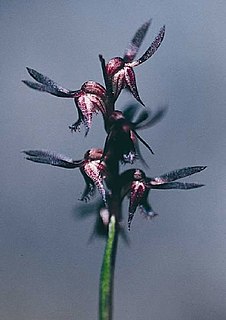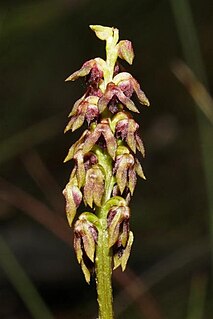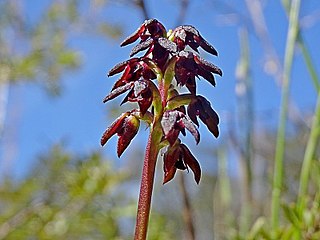Genoplesium rufum, commonly known as the rufous midge-orchid, is a species of orchid endemic to New South Wales. It has a single thin, wiry leaf and up to twenty five drooping, pinkish or reddish flowers on a flowering stem which is fused to the lower part of the leaf. It was formerly thought to range from Queensland to South Australia and Tasmania but specimens in other states are now assigned to Genoplesium clivicola.

Genoplesium filiforme, commonly known as the glandular midge orchid is a small terrestrial orchid endemic to the east coast of Australia. It has a single thin leaf and up to thirty greenish to purple flowers with a reddish-purple labellum. The edges of its flower parts are covered with many short glandular hairs. It is found from southern Queensland to southern New South Wales.
Genoplesium acuminatum, commonly known as the pointed midge orchid and as Corunastylis acuminata in Australia, is a small terrestrial orchid endemic to eastern Australia. It has a single thin leaf fused to the flowering stem and up to sixteen small, hairy, greenish purple to brownish purple flowers. It is found in coastal and near-coastal parts of New South Wales and Queensland.
Genoplesium littorale, commonly known as the Tuncurry midge orchid, is a species of small terrestrial orchid endemic that is endemic to New South Wales. It has a single thin leaf fused to the flowering stem and up to thirty small green flowers with a purple-brown labellum. It is only known from fewer than two thousand plants in a small area on the New South Wales North Coast and is critically endangered.
Genoplesium anthracinum, commonly known as the black midge orchid is a species of small terrestrial orchid endemic to New South Wales. It has a single thin leaf fused to the flowering stem and up to thirty small, coal black flowers. It grows in heath in coastal and near-coastal parts of the Northern Rivers area.

Genoplesium apostasioides, commonly known as the freak midge orchid, is a small terrestrial orchid endemic to New South Wales. It has a single thin leaf fused to the flowering stem and up to fifteen small, yellowish green flowers with a reddish labellum. The flowers do not open widely and are self-pollinating. It grows in heath and shallow moss gardens on rock ledges from the Blue Mountains to Nerriga.
Genoplesium bishopii, commonly known as the Gibraltar Range midge orchid, is a small terrestrial orchid endemic to New South Wales. It has a single thin leaf fused to the flowering stem and up to thirty small, dark purplish red flowers. It grows in heathy forest and on the edges of swamps in the Gibraltar Range National Park.
Genoplesium brachystachyum, commonly known as the Rocky Cape midge orchid or short-spike midge orchid, is a species of small terrestrial orchid endemic to Tasmania. It has a single thin leaf fused to the flowering stem and up to twelve small, green to brownish green, and reddish flowers. It usually grows in heath in rocky places near the coast.
Corunastylis capparina is a small terrestrial orchid endemic to Victoria. It is one of the midge orchids and has a single thin leaf fused to the flowering stem and up to twenty small, green flowers with purple markings. It is a rare species, found only in a small area in the south-east of the state.
Genoplesium cranei, commonly known as the Blackall Range midge orchid, is a small terrestrial orchid endemic to the Blackall Range in Queensland. It has a single thin leaf fused to the flowering stem and up to twenty small, green to greenish yellow flowers with reddish markings. It grows in open forest with shrubs and grasses.

Corunastylis ciliata, commonly known as the fringed midge orchid, is a small terrestrial orchid endemic to southern Australia. It has a single thin leaf fused to the flowering stem and up to fifteen small, green to greenish yellow flowers with purplish markings and a reddish purple labellum. It was formerly included with Corunastylis archeri, and C. ciliata is regarded as a synonym of Genoplesium archeri by the World Checklist of Selected Plant Families. Plants in this species have fewer, more erect flowers, a less-hairy labellum and have different coloration than C. archeri.
Genoplesium firthii, commonly known as Firth's midge orchid, is a species of small terrestrial orchid endemic to Tasmania. It has a single thin leaf fused to the flowering stem and up to six small, yellowish green or reddish flowers with a red labellum. It grows in coastal heath and scrub and is currently known only from a single population of about twelve plants near Coles Bay.
Genoplesium formosum, commonly known as the Cathcart midge orchid is a small terrestrial orchid found in southern New South Wales. It has a single thin leaf and up to twenty five dark reddish purple flowers with darker lines.
Genoplesium ostrinum, commonly known as the purple midge orchid is a species of small terrestrial orchid that is endemic to New South Wales. It has a single thin leaf and up to ten dark purple flowers with darker stripes and a hairy labellum which vibrates in the slightest breeze.

Genoplesium rhyoliticum, commonly known as the Pambula midge-orchid or rhyolite midge orchid and as Corunastylis rhyolitica in Australia, is a species of orchid endemic to New South Wales. It is a small orchid with up to eighteen dark, purplish-black flowers and is only known from six sites on the south coast where it grows in shallow soil over rhyolite.

Genoplesium ruppii, commonly known as Rupp's midge orchid, is a species of small terrestrial orchid that is endemic to eastern Australia. It has a single thin leaf fused to the flowering stem and up to twenty five small, hairy green flowers with a purple labellum.
Genoplesium sagittiferum, commonly known as the horned midge orchid, is a species of small terrestrial orchid that is endemic to New South Wales. It has a single thin leaf fused to the flowering stem and up to ten small, yellowish-green flowers with a hairy reddish labellum.

Genoplesium vernale, commonly known as the spring midge orchid or East Lynne midge orchid is a small terrestrial orchid which is endemic to a small area on the south coast of New South Wales. It has a single thin leaf and up to twenty five dark purplish-black flowers with tiny glandular hairs on the sepals and petals.
Genoplesium superbum, commonly known as the Kangarooby midge orchid, is a species of small terrestrial orchid that is endemic to New South Wales. It has a single thin leaf and up to thirty two hairy, light reddish flowers which lean downwards and have a dark purple labellum.
Corunastylis densa, commonly known as the dense midge orchid, is a small terrestrial orchid endemic to eastern Australia. It has a single thin leaf fused to the flowering stem and up to twenty five densely crowded reddish-brown to dark purplish-brown flowers. It is found between the New England National Park and the Moroka River.





